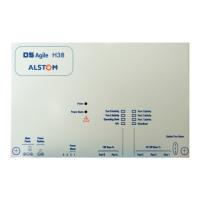Global Documentation H38x/EN GL/D11
DS Agile H38x
Page 53/53
10. GLOSSARY
100Base-Fx
The fibre optic ports are full/half duplex at 100 Mbps only.
10Base-Tx and
100Base-TX
The copper ports are full/half duplex and auto-sense the
transmission speed. They will auto-negotiate with the connected
device to determine the optimal speed. When the connected
device is only capable of transmitting at 10 Mbps, the switch
makes a 10 Mbps connection.
Cat. 5
Category 5 unshielded twisted pair (UTP) cabling. An Ethernet
network operating at 10 Mbits/second (10BASE-Tx) will often
tolerate low quality cables, but at 100 Mbits/second (10BASE-
Tx) the cable must be rated as Category 5, or Cat 5 or Cat V, by
the Electronic Industry Association (EIA). This rating is printed
on the cable jacket. Cat 5 cable contains eight conductors,
arranged in four twisted pairs, and terminated with an RJ45 type
connector. In addition, there are restrictions on maximum cable
length for both 10 and 100 Mbits/second networks.
DANP
Doubly attached node for Paralle Redundancy Protocol (PRP)
Fast Ethernet
An Ethernet system that is designed to operate at 100 Mbps.
Half-duplex
A system that allows packets to be transmitted and received, but
not at the same time. Contrast with full-duplex.
LAN
Local Area Network
MAC address
The Media Access Control address is a unique 48-bit hardware
address assigned to every network interface card. Usually
written in the form 01:23:45:67:89:ab.
MIB
See “Management Information Base” in the Functional
Description section.
NTP
Network Time Protocol
PHY
The OSI Physical Layer: The physical layer provides for
transmission of cells over a physical medium.
Power management
If there is no cable on a port, most of the circuitry for that port is
disabled to save power.
PRP
Parallel redundancy protocol. Achieving bumpless Ethernet
connectivity using redundancy in accordance with IEC 62439-3
PTP
Precision time protocol. Achieving highly accurate time
synchronisation over Ethernet in accordance with IEEE1588.
RedBox
Redundant Ethernet Box. A device such as this one for
connecting singly attached nodes (SANs) to PRP networks
RMON
Short for remote monitoring, a network management protocol
that allows network information to be gathered at a single
workstation. Whereas SNMP gathers network data from a single
type of Management Information Base (MIB), RMON 1 defines
nine additional MIBs that provide a much richer set of data about
network usage. For RMON to work, network devices, such as
hubs and switches, must be designed to support it. The newest
version of RMON, RMON 2, provides data about traffic at the
network layer in addition to the physical layer. This allows
administrators to analyze traffic by protocol.
SNMP
Simple Network Management Protocol is the protocol governing
network management and the monitoring of network devices and
their functions
SNTP
Simple Network Time Protocol.

